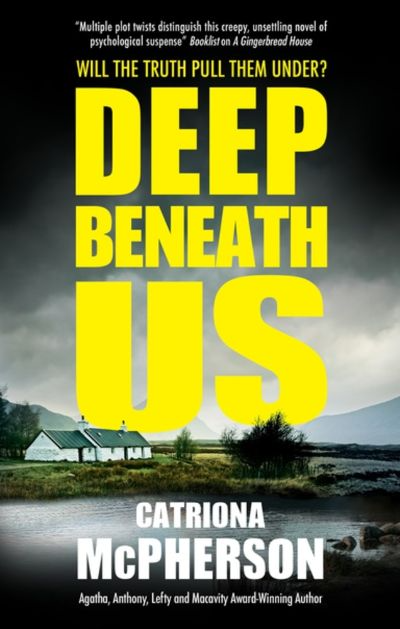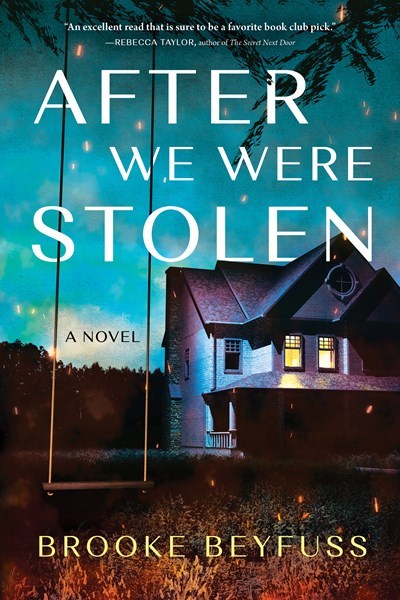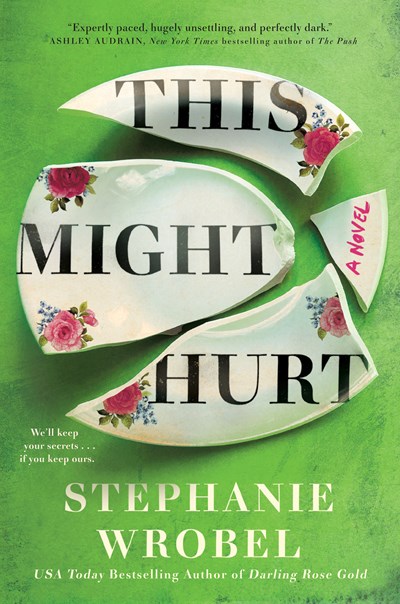Social media replaces life for the Iverson family, which is headed by freezing-cold May Iverson, whose Mother May I videos have chronicled the childhoods and now young adulthood of her daughters January, March, April, and twins June and July. Their real last name is Iniesta, but their Latino father and mixed-race identities are mostly swept under the carefully curated rug, except when it works for May to use it as content. The girls are both hyper-aware of their every movement as fodder for videos—how could they not be, when a genuine emotion is met with the request to do it again for the camera?—and bone-deep in the influencer life. It all threatens to collapse when May’s second husband, happily for the brand named August, is found murdered at their white-on-white home, a fire set seemingly to cover the crime. As though from multiple camera angles, the narrative unfolds over different time lines and from various characters’ perspectives, including, perfectly, “We Who Grew Up Watching the Iversons” and “We the Followers of Mother May I.” As the engaging and incredible lives of the Iverson/Iniestas unspool, a grotesque view of modern life is put under the microscope, with no pink-marble stone left unturned. One for We Who Grew Up Watching the Kardashians, of course, but also for fans of family drama and sociological skewerings.
Siblings
Tabitha is compelled by the spiteful actions of her ex-husband to move back to her childhood home. This is not a cozy, safe space as one might hope. It is a sort of compound: two schoolhouses on different sides of a reservoir, one occupied by her family, the other by her uncle’s family. In the past, four cousins, Tabitha the youngest, ran and played like a pack. But her mother is an unstable artist, her father and uncle killed themselves, and her sister and cousin married each other at age 16. Now, cousin Davey purportedly dies by suicide as well, leaving his property to Tabitha. But is that what really happened? Davey’s two cronies, along with three smart teens, use skills learned from TV crime dramas and DNA analysis to get to the bottom of it all. The characters are captivating, the atmosphere is dark and dour, and the wretched weather contributes to the overall tone of the book. The novel is set in Scotland and the use of Scottish dialect and expressions is sometimes daunting, but never gets in the way of the telling. To say that the plot here is a tangled mess may be an understatement, but the untangling is a treat.
The Jansen family is newly arrived in LA from Melbourne, Australia. Janus, the father of the family, is sure the screenplay of his successful novel will be their fortune. Things take a very sinister turn when daughter Liv wakes with a hangover and bruises, and her parents seem furious with her. Her bedroom is padlocked shut—it’s the law, Janus and wife Kay say, because there’s a mold issue. Son Casper suspects that there’s something much worse afoot; his parents won’t talk to each other and barely seem aware of him, and that locked room is suspicious. Liv herself can’t remember anything but starts to catch on that there’s a problem when her friend who was out with her on the mysterious night in question won’t return texts. What happened? That’s carefully revealed in a tense psychological thriller that masterfully examines love and fear from every angle. The fully fleshed out teenage characters make this a solid YA crossunder. Get it on your TBR list!
I love the kind of us-and-them stories set in places like the Hamptons, and the latest by DeCarolis (The Guilty Husband, Deadly Little Lies) is packed with twists. Alex and Maddie Walker are sisters who look so alike and are so close in age that people think they’re twins. Their mother referred to them that way, a glimpse of love amid her boozy, selfish ways. Now Mom’s long gone, and the sisters, who are now in their twenties, are distant after an argument that followed her funeral. But when Alex doesn’t hear from Maddie, who has been in the Hamptons for the summer, she heads to that tony town to get to the bottom of things. What she finds is very strange—Maddie had been living at one of the swankiest houses in the area, Blackwell Manor. Alex stays with the Blackwells herself, keeping a safe distance from their rich but miserable lives—until things take a turn when another young woman goes missing. As Alex becomes a thorn in the police’s side, she uncovers secrets about the present and the distant past. Dark sexual themes feature amid the absorbing suburban suspense that’s told from multiple, tantalizing viewpoints.
“Some families are haunted. The stuff of the past, the traumas and the ghosts—they just go on and on,” thinks Caleb “Cale” Casey, a successful real-estate broker in Hawaii who has been estranged for almost 30 years from his brother Ambrose, who runs a construction company back in their small Connecticut hometown. Both are tormented by a terrible secret that they buried as teenagers in Gibbs Pond. When a real-estate developer announces plans to dredge the pond in preparation for further development, Cale reluctantly returns home. Unbeknownst to the brothers, Lily Rowe, the contractor in charge of the dredging, also suffers from a dark family history, a childhood of abuse and neglect, shared with her troubled sibling Ray, that led to a shocking act of violence. How these well-drawn traumatized characters and their secrets collide in the present day, permanently changing the course of their lives, is the theme of Flaherty’s beautifully written debut. His Connecticut is not the monied suburbia of Rick Moody and John Cheever, but a rural working-class community more reminiscent of Daniel Woodrell’s Ozark mountain towns. After a strong buildup, the conclusion felt a bit anticlimactic. Still, this sad novel about the corrosive effects of family trauma and pain will linger in readers’ minds.
Judith and Katherine, or as they prefer, Jude and Kat, are mirror-image identical twins (they have the same features on opposite sides of their bodies, such as the same birthmark on opposite shoulders). But there is one big difference. Jude can remember all of their 22 years, but Kat has recently survived a terrible car accident that has left her with amnesia. Experiencing everything “again for the very first time,” she relies on Jude to tell her their life story, because, Jude says, their mother is dead and their father took off years ago. Some things seem puzzling, such as why the photos of their before-the-accident European trip don’t show the sisters at all, only landmarks. Readers learn why in those sections of the book that look at life before the crash, when the girls and their mother left mainstream society to live with the controlling King Bash, whose mantra was “What you think, is.” The pressure to will happiness and satisfaction into being, and the child abuse led by Bash, brews a toxic storm that Jude tries to keep in their past. But the past threatens to explode when a mysterious figure starts turning up at random places in the present. Kahler has a quietly compelling way of revealing secrets and of portraying a close sibling bond, creating an unusual debut novel (as Karen Abbott, Kahler is an Edgar Award nominee for Best Fact Crime for The Ghosts of Eden Park) that will be a hit with those who enjoyed the recent religious-cult documentaries Shiny Happy People and Keep Sweet: Pray and Obey
Theodora, or Teddy, Angstrom’s father, died by suicide at the 10-year anniversary of her older sister, Angie’s, disappearance as a teenager. Her mother is now to be found lying on the floor with her ancient dog, “Two commas facing one another, small nothing between them.” It’s up to Teddy to make arrangements, exhausted though she is with her teaching job on top of this unwanted task. While doing so, she discovers that her father was on a relentless quest to find Angie, and his failure seems to have been the last straw. Learning that Angie’s disappearance is a hot topic on the message-board site Reddit, where Teddy also finds details about another young woman who disappeared and was found to have run away from her abusive family, sparks curiosity in Teddy. It soon turns to obsession as the amateur sleuth meets a strange, needy young woman who was helping Teddy’s father with his detective work and starts getting messages from a stranger who might know more about Angie’s fate, if she can only find him. As the twisting tale unwinds, unsavory details about fans of true crime, and of message boards where vicious and glib voyeurs can anonymously post intimate questions and tacky rumors about crime victims, will open readers’ eyes to survivors’ reality. A gritty, realistically ambivalent look at how insiders and outsiders experience crime, with a realistic main character to boot.
Sophocles’ play Antigone, written in 441 BCE, is here pulled into modernity by Burt, a consultant for the United States Holocaust Memorial Museum. The ancient play sees brothers instigate a civil war, and one of their daughters, Antigone, defies her uncle and puts her brother first. So it is in The Dig, which opens amid a civil war, this time in 1993 Sarajevo, Bosnia. Andela, age three, and her brother Mujo, six, are found by American construction-worker brothers in the rubble of a destroyed building, their dead mother nearby. Their Antigone takes place in Thebes, Minnesota, where the children, now called Antonia and Paul, have a “typical American upbringing, blah, blah, no drama,” after being adopted by Eddie King, one of the brothers. Except it’s not really drama free. The blond and hearty residents of Thebes are not ready for the dark-haired, reticent Antonia and Paul, and Eddie dies of an overdose when he can’t handle the new responsibility. What the King family decides for the town is taken as local law, but Antonia defies her Uncle Christopher, graduating from law school and decidedly not working for her family. Paul rebels even more, protesting the Kings’ development of a new shopping area that displaces his Somali immigrant friends and then disappearing. Finding him and getting to the bottom of their pasts, both in Bosnia and more recently, will draw Antonia into a storm of lies and corruption and a fierce battle for control of her life. Feelings when ambition and family collide are no different today than in 411 BCE, and the resulting spectacle is no less captivating.
Avery lives outside in a tent while her family sleeps inside. Over the years, she’s learned to start her own fires; sometimes it doesn’t work and she’s freezing and hungry, but things aren’t much better for her nine siblings inside. Their parents, cult leaders preparing the family for when they’re the only ones left on Earth, emphasize toughness over all else. The children get their hopes up when the parents announce a buddy system, but it turns out that your buddy is the one who will be punished if you leave, so escape seems unthinkable. Avery finds a way out, though, accompanied by her little brother Cole, only to discover that they’re famous in the outside world as victims of years-ago child abductions. What happened the night the pair escaped and how they will navigate notoriety and society’s expectations are mysteries that will keep readers rapt. Also engrossing are the overwhelming emotions involved with both staying and going, the realization that just because the biggest problem is over doesn’t mean everything is rosy, and the ways tormented people treat one another even when survival is no longer at stake. Avery has grit and attitude to spare and will stay with readers long after the last page.
The first crime here is psychological abuse of two sisters whose father, named only as Sir, is obsessed with building their resilience (“Lord knows you’re not going to get by on talent or gifts”). Sir’s isolated, scared little girls can’t go to bed at night unless they achieve enough points. Chores count, but they must also endure “tests” like sitting in the snow without a coat for an hour, holding their breath for two minutes, and kneeling on broken glass. The abuse leads the younger sister to become obsessed with Houdini and perfect a show based on his escapes, with the psychological underpinnings of that quest not lost on her or on readers. Fast forward to adulthood and there’s possibly a new crime afoot, or at least a mystery, as one sister, Natalie, visits a Maine island where she suspects her sister, Kit, is captive in a cult led by the reclusive, mysterious Teacher. The markers of a cult are glaring, but is Kit being held against her will and what’s behind the other residents’ willingness to obey? The solution is satisfying here, and getting to it will bring home to readers Teacher’s declaration of the book’s central truth: “The difference between a cocoon and a straitjacket [is] perspective.”










